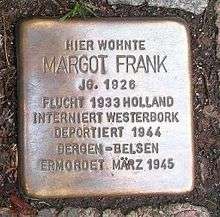Margot Frank
Margot Betti Frank (February 16, 1926 – February or March 1945)[2] was the elder daughter of Otto Frank and Edith Frank and the elder sister of Anne Frank. Margot's deportation order from the Gestapo hastened the Frank family into hiding. According to the diary of her younger sister, Anne, Margot kept a diary of her own, but no trace of Margot's diary has ever been found. She died in Bergen-Belsen concentration camp.[3]

Margot Betti Frank | |
|---|---|
Margot Frank, May 1942 | |
| Born | Margot Betti Frank February 16, 1926 |
| Died | February or March 1945 (Age 18 or 19) |
| Cause of death | Typhus |
| Nationality | German until 1941; stateless from 1941[1] |
| Education | Ludwig-Richter School |
| Known for | Older Sister of Anne Frank |
| Home town | Frankfurt am Main, Germany |
| Parent(s) | Otto Frank Edith Holländer |
| Relatives | Anne Frank (sister) Buddy Elias (cousin) |
Early life and education
Margot Betti Frank, named after maternal aunt Bettina Holländer (1898–1914), was born in Frankfurt, Germany, to Jewish parents, Otto and Edith, and lived in the outer suburbs of the city with her parents, Otto Frank and Edith Frank-Holländer, and also her younger sister Anne Frank, during the early years of her life.
She attended the Ludwig-Richter School in Frankfurt until the appointment of Adolf Hitler on January 30, 1933, to the position of chancellor in Germany brought an increase of anti-Jewish measures, among which was the expulsion of Jewish schoolchildren from non-denominational schools. In response to the rising tide of anti-semitism, the family decided to follow the 63,000 other Jews who had left Germany that year and immigrate to Amsterdam in the Netherlands. Edith Frank and her daughters moved in with her mother in Aachen in June 1933 until Otto Frank found accommodation in Amsterdam. Margot and her mother left Germany to join him on December 5, 1933, followed by Anne in February 1934. Margot was enrolled in an elementary school on Amsterdam's Jekerstraat, close to their new address. Despite initial problems with the Dutch language, Margot went on to become a star pupil. She achieved excellent academic results until an anti-Jewish law imposed a year after the 1940 German invasion of the Netherlands demanded her removal to a Jewish lyceum. There she displayed the studiousness and intelligence which had made her noteworthy at her previous schools and was remembered by former pupils as virtuous, reserved, and very obedient. Margot had a large circle of friends and enjoyed rowing and playing tennis in her spare time. In her diary, Anne recounted instances of their mother suggesting she emulate Margot, and although she wrote of admiring her sister in some respects for being handsome and clever, Anne sought to define her own individuality without role models. Margot is also shown to have a much better relationship with at their mother, and had a much more modest and tolerant nature as opposed to Anne, who was determined and often spoke her mind.
While Anne inherited her father's ambivalence towards the Torah, Margot followed her mother's example and became involved in Amsterdam's Jewish community. She took Hebrew classes, attended synagogue, and in 1941 joined a Dutch Zionist club for young people who wanted to immigrate to Palestine to found a Jewish state, where, according to Anne, she wished to become a midwife.
On July 5, 1942, she received a notice to report to a labor camp and the next day went into hiding with her family in a secret annex of a house. They were later joined by four other Jewish refugees and remained hidden for two years until they were betrayed on August 4, 1944.[4]

Arrest and death
Along with the other occupants of the hiding place, Margot Frank was arrested by the Gestapo on 4 August 1944, and detained in their headquarters overnight before being taken to a cell in a nearby prison for three days. From here they were taken by train, on 8 August, to the Dutch Westerbork concentration camp. As the Frank family had failed to respond to Margot's call-up notice in 1942 and had been discovered in hiding, they (along with Fritz Pfeffer and the Van Pels family) were declared criminals by the camp's officials and detained in its punishment block to be sentenced to hard labor in the battery dismantling plant. They remained there until they were selected for Westerbork's last deportation to Auschwitz on September 3, 1944. Margot and Anne were transferred to Bergen-Belsen concentration camp on October 30, where both contracted typhus in the winter of 1944.
Margot Frank died in February or March 1945 at the age of 18 or 19 due to typhus. A few days later, Anne died due to the same illness. Janny Brandes-Brilleslijper and her sister Lientje buried them together in one of the camp's mass graves; in August 1945, once she came back to the Netherlands and recovered from typhus, Janny wrote to Otto Frank and informed him that both of his daughters had died.
Otto Frank was the only one to survive out of the eight people who went into hiding. When he returned to Amsterdam he was given Anne's diary by Miep Gies, which he later published as a remembrance to her. Along with Anne, Margot Frank also wrote a diary during their time in hiding (Anne mentioned her sister's diary in her own) but Margot's diary was never found.[5] However, many authors wrote fan-based diaries of Margot such as the novel The Silent Sister by Mazal Alouf-Mizrahi. Letters written by both Frank sisters to American pen pals were published in 2003.[6] Buddy Elias (1925–2015) was Anne's first cousin and last surviving close relative.
References
- Müller 1999, pp. 128–130
- "Archived copy". Archived from the original on 2018-01-02. Retrieved 2018-03-05.CS1 maint: archived copy as title (link)
- Rittner, Carol (1998). Anne Frank in the world: essays and reflections. M.E. Sharpe. p. 111. ISBN 978-0-7656-0020-2.
- Barnouw, David; Van Der Stroom, Gerrold, eds. (2003). The Diary of Anne Frank: The Revised Critical Edition. New York: Doubleday. p. 21. ISBN 0-385-50847-6.
- "Margot Frank". Anne Frank Stichting. Retrieved 30 October 2015.
- "Anne Frank and her Iowa Penpal". Archived from the original on 2013-12-09. Retrieved 2014-03-16.
Further reading
- Anne Frank. The Diary of Anne Frank: The Revised Critical Edition, edited by David Barnouw and Gerrold Van der Stroom, translated by Arnold J. Pomerans, compiled by H. J. J. Hardy, second edition, Doubleday, 2001.
- Willy Lindwer. The Last Seven Months of Anne Frank, Pan Macmillan, 1989.
- Jeroen De Bruyn and Joop van Wijk. Anne Frank: The Untold Story. The hidden truth about Elli Vossen, the youngest helper of the Secret Annex, Bep Voskuijl Producties, 2018.
- Rubin, Susan Goldman. Searching for Anne Frank: Letters from Amsterdam to Iowa, Abrams, 2003.
- Miep Gies and Alison Leslie Gold. Anne Frank Remembered, Simon and Schuster, 1988.